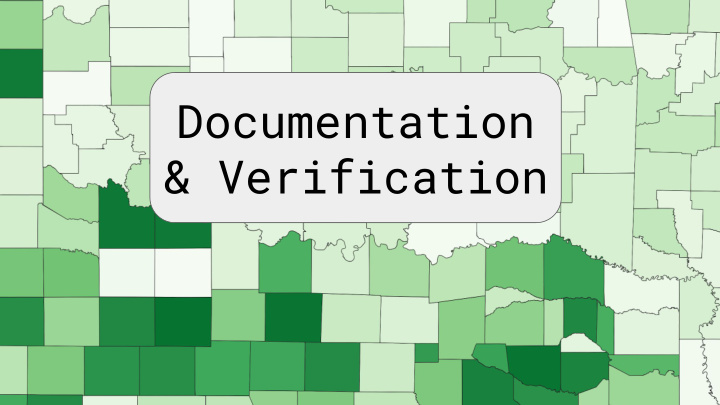



Documentation & Verification
Why do we document? Transparency - we want end users to know: ● What we modified e.g. merged precinct x with precinct y ○ Why we modified e.g. there were no matches for precinct x in the ○ results, so we called up x’s county and they told us that x was merged with y to protect voter privacy. Reproducibility ● Enables end users to audit your process should they desire to do so. ○ Enables folks to learn from the work you did ○ Came up with a great new process for matching? Document it! ■ Organizes your workflow ● Effectively keep track of what you have done so you know what is left ○
How to Document Effectively Start Documentation at the ● BEGINNING Saves you the effort of trying to ○ remember everything you did at the end Can be an effective method of organizing ○ your process More accurate than doing it all at the ○ end Make it easy to understand ● Be consistent in your presentation ○ For example, organize by county and ■ then go through modifications in the same order for each county Use tables and folders ○ Hyperlink to documents to make it ● easier for end users to navigate.
What do we keep track of? Decisions that generalize across all states ● What to do with mail in votes? ○ Include them: e.g. uniformly distribute them across the precincts in the ■ geometry to which they were aggregated. Exclude them because you don’t really know which precinct they came from. ■ Decisions that are specific to particular states or even ● counties How we matched precinct results to precinct geometries ○ If you used a simple matching rule that worked for most of the precincts, ■ how did you handle the exceptions? Sources files ● Shapefile source ○ Election results source ○ Explain column names and other properties ● Shapefile limits column names to 10 characters ○
Sources For each source file one should try to include: ● The name of the provider (in the README) ○ A link to where you got the file, if possible (in the README) ○ The actual file (in Github) ○ Which sources to include? ● As many as possible! ○ Shapefile ■ Election results ■ Other files you used in your process e.g. a lookup table that translates precinct ■ codes to precinct names for that one troublesome county which didn’t follow the same convention as the rest of the state.
Processing and Changes
Washington Okanogan County State
Washington State Okanogan County, Precinct 73 is missing results in the 2018 General Election Process: 73 1. Contact the Okanogan County Elections Administrator. 2. Elections Administrator sent a 212 spread a spreadsheet with precincts that were merged into other precincts. Based on the spreadsheet, we need to merge 73 into 212.
Shape Changes Before 3. Use QGIS to merge precinct 73 into precinct 212 and update the metadata accordingly After
Shape Changes 4. Document what you did and why you did it (including your source document if applicable - the lookup table in this case).
Verification Communicate to end ● users about the quality of your data Can save them time if ● they intended on doing similar verification Shameless ● self-promotion for Open Precinct's new verification script
Verification We want to measure difference between the qualities in the ● election shapefile that we produced and their expected values in a way that is consistent across all election shapefiles. Shapefile Expected Value Source Ideally: Measuring technique Attribute Election MEDSL, County websites Minimal observed/expected, Results difference* VoteScore Geometrie US Census Bureau No holes, Shapley’s symmetric s (shapefiles) covers state difference *In states with a significant number of mail in ballots, you may not want to match exactly.
Verification Moreover, we want to ensure that ● our end users will be able to use Python packages such as GerryChain on the election shapefiles that we produce. Accordingly, we simply try to use ● those libraries in our verification script. Election Shapefiles are much more ● valuable when end users can do analysis on them with tools like GerryChain, so if the attempt to use any of the libraries fails, we probably won’t upload it until we are able to fix the underlying issue.
Recap: Documentation Goals Transparency - we want end users to know: ● What we modified e.g. merged precinct x with precinct y ○ Why we modified e.g. there were no matches for precinct x in the ○ results, so we called up x’s county and they told us that x was merged with y to protect voter privacy. Reproducibility ● Enables end users to audit your process should they desire to do so. ○ Enables folks to learn from the work you did ○ Came up with a great new process for matching? Document it! ■ Organizes your workflow ● Effectively keep track of what you have done so you know what is left ○
Validation and Accuracy: Meta-documentation A single black box grade for each shapefile would be simple, but ● ultimately unconvincing End users should be able to know how each score was computed, ● have confidence that the process is deterministic, and be able to easily acquire information about what each score means. To that end we have: ● Published the entire verification codebase and a guide demonstrating how to use it ○ Implemented auto-generated reports ○ Hyperlinked scores on the report to their definitions and implementations ○
Questions? hwheelen@princeton.edu bdemers@princeton.edu
Recommend
More recommend